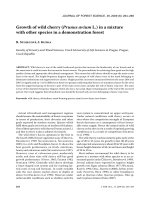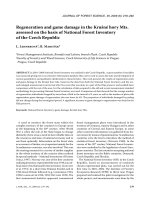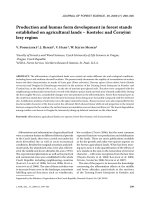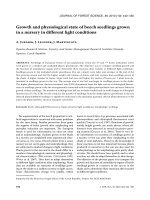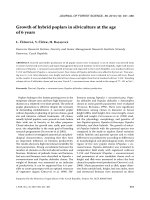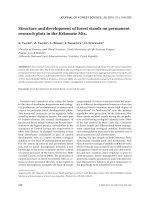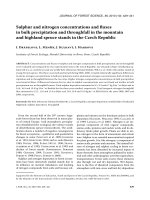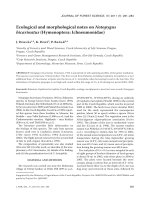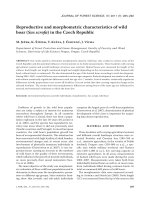Báo cáo lâm nghiệp:"Growth and biomass partitioning of Fagus sylvatica L. and Quercus robur L. seedlings in response to shading and small changes in the R/FR-ratio of radiation" pot
Bạn đang xem bản rút gọn của tài liệu. Xem và tải ngay bản đầy đủ của tài liệu tại đây (259.74 KB, 9 trang )
163
Ann. For. Sci. 60 (2003) 163–171
© INRA, EDP Sciences, 2003
DOI: 10.1051/forest:2003009
Original article
Growth and biomass partitioning of Fagus sylvatica L. and Quercus
robur L. seedlings in response to shading and small changes
in the R/FR-ratio of radiation
Christian Ammer*
Lehrstuhl für Waldbau, Department für Ökosystem- und Landschaftsmanagement, Wissenschaftszentrum für Ernährung, Landnutzung und Umwelt der
TU München, Am Hochanger 13, 85354 Freising, Germany
(Received 5 May 2002; accepted 28 August 2002)
Abstract – The effects of shading levels, comparable to the light quantity and quality below the canopy of a Norway spruce (Picea abies [L.]
Karst.) stand on one year old European beech (Fagus sylvatica L.) and pendunculate oak (Quercus robur L.) were tested. The treatments were:
shading of plants exposed to “natural shade” by using green synthetic nets (PAR reduced to 32.6%, R/FR-ratio 1.04), shading of plants exposed
to “neutral shade” by using black nets (PAR reduced to 24.7%, R/FR-ratio 1.13), no shading (control, PAR 100%, R/FR-ratio 1.15). Beech
seedlings showed a strong decrease in height, diameter, stem-, branch-, leaf- and root dry mass with decreasing light quantity. Neither growth
rates nor total yield indicated an impact of slightly changed light quality (R/FR-ratio 1.04) on growth and biomass partitioning of beech. Relative
growth rate of the main stem dry mass of oak was considerably higher for the seedlings of the shade treatment with the reduced R/FR-ratio than
for the control and the other shade treatment whereas branch dry biomass exposed to changed light quantity and quality was reduced
disproportional, resulting in the lowest branch-stem-ratio. The tallest oak seedlings were found under the green nets (treatment with reduced
light quantity and quality), whereas the control showed the shortest seedlings.
light quality / shading / pedunculate oak / European beech
Résumé – Répartition de la croissance et de la biomasse de plants de Fagus sylvatica L. et de Quercus robur L. soumis à ombrage et à
de faibles changements du rapport R/FR de radiation. On a testé l’effet sur des plants de un an de hêtre (Fagus sylvatica L.) et de chêne
pédonculé (Quercus robur L.) de différents niveaux d’ombrage, reproduisant les conditions de lumière en quantité et qualité d’un couvert de
peuplement d’épicéa (Picea abies Karst.). Les traitements furent les suivants : plants soumis à une « ombre naturelle » en utilisant des filets
synthétiques verts (réduction du PAR à 32,6 %, rapport R/FR 1,04) ; plants soumis à une « ombre neutre », en utilisant des filets noirs (réduction
de PAR à 24,6 %, rapport R/FR 1,13) ; pas d’ombrage (témoin PAR 100 %, rapport R/FR 1,15). Pour les plants de hêtre, la réduction de la
quantité de lumière s’est traduite par une forte diminution de la hauteur et du diamètre, ainsi que du poids sec des tiges, branches, feuilles et
racines. Un faible changement de la qualité de la lumière (rapport R/FR de 1,04) n’a pas d’effet sur la croissance et la répartition de la biomasse.
En ce qui concerne les plants de chêne, la croissance en matière sèche de la tige principale est proportionnellement plus élevée pour le traitement
ombrage avec rapport R/FR réduit que pour le témoin ou l’autre traitement d’ombrage. Un changement en quantité et qualité de la lumière induit
donc une réduction du rapport branche/tige. On obtenait les plants de chêne les plus grands sous filet vert (traitement avec réduction en quantité
et qualité de la lumière) alors que les plus petits étaient dans le témoin.
qualité de la lumière / ombrage / chêne pédonculé / hêtre
1. INTRODUCTION
As a consequence of the serious damages by biotic and
abiotic factors to pure conifer stands, the conversion of those
stands into mixed stands has become one of the most
important tasks of silviculture in central Europe during the last
decade [25]. For this purpose Fagus sylvatica L. or Quercus
robur L. are often planted or sown under the canopy of conifer
stands [2, 43] where the seedlings experience environmental
conditions different from those in open field for a prolonged
period.
It is well known, that growth and biomass partitioning of
seedlings shaded by overstorey trees are strongly affected by
modifications in light conditions caused by the canopy trees
[4]. As a result seedlings of shaded European beech (Fagus
sylvatica L.) and pendunculate oak (Quercus robur L.)
* Correspondence and reprints
Tel.: 0049-8161-714686; fax: 0049-8161-714616; e-mail:
164 Ch. Ammer
showed different growth patterns related to seedlings grown
up in open field [9, 10]. This was ascertained with seedlings
under the canopy of old stands [11, 19, 21, 31] as well as in
shading experiments [5, 22, 52, 55]. However, it is not known
whether the modified growth patterns are caused by the
reduction of radiation intensity coming through the canopy
and/or by the changed spectral composition of the radiation
below the canopy. In particular the ratio of the red components
of radiation to those of the far red (R/FR-ratio) is altered below
the crowns of the canopy trees due to the selective absorption
of light by their leaves [33, 42, 48].
In a number of studies the R/FR-ratio of radiation was
proven to determine the status of phytochrome equilibrium,
which was found to control various photomorphogenetic plant
responses [36, 45]. Examples for such responses include
accelerated extension growth, apical dominance and reduced
branching [45]. This behaviour is typical for plants which
grew in light conditions where the R/FR-ratio was reduced and
can be summarized as the so called “shade avoidance
syndrome” [45]. Since the future value of broad-leaf seedlings
is strongly correlated with their branchiness and uprightness of
the main shoot [29] these responses are of silvicultural
interest.
However, only few studies investigated the effects of a
modified R/FR-ratio on growth and biomass partitioning of
woody plants [50]. Moreover, some of these studies are
focused on how the variation in R/FR-ratio at the top of the
shoots and the related growth responses are caused by
neighbouring plants and not by canopy trees [20, 41], or they
investigated the effect of R/FR-ratios different from those of
natural environments [37, 38]. The results of other studies, in
which the effects of light intensity were separated from those
of light quality are not consistent [30, 39]. The ability to
respond to modifications in the R/FR-ratio by changes in
growth patterns seems to depend on the investigated species
and its shade tolerance [26, 28]. Against this background the
objective of the present study was to investigate in a shading
experiment (i) how shading comparable to the light conditions
below the canopy of a heavily thinned pure Norway spruce
(Picea abies [L.] Karst.) stand affects growth and biomass
partitioning of seedlings of European beech (Fagus sylvatica
L.) and pendunculate oak (Quercus robur L.) and (ii) to what
extent reductions of light quantity and quality, respectively,
account for differences in growth and biomass partitioning
between shaded and unshaded seedlings.
2. MATERIALS AND METHODS
2.1. Treatments
Following the recommendations by Smith et al. [47] the experi-
ment was conducted with the following three treatments: (i) Plants
exposed to “natural shade” [47] by using a green synthetic net (Heiss-
ner
®
). The amount of the photosynthetically radiation (PAR, total
photon flux in mmol m
–2
s
–1
between 400 and 700 nm) below the
green net was 32.6% of the respective amount above. The R/FR ratio
(photon flux between 655 and 665 nm divided by photon flux between
725 and 735 nm), which is equal 1.15 in open field and sunsets >10°
[45] was reduced by this net to 1.04 (figure 1). The measurements of
PAR and R/FR-ratio were conducted at the GSF-research center in
Munich-Neuherberg using a spectroradiometer. Reduced PAR and
reduced R/FR-ratio are representative for light conditions, which were
detected below the canopy of a heavily thinned pure Norway spruce
(Picea abies [L.] Karst.) stand [1]. (ii) Plants exposed to “neutral
shade” [47] by using a black net (Heissner
®
) which was identical to
the green net regarding material and width of meshes. However, the
amount of PAR was reduced to 24.7% below the net, i.e. the reduction
of light intensity by the black net exceeds the respective diminution
by the green net. On the contrary the R/FR ratio was nearly unaffected
by the black net and amounted to 1.13. (iii) Plants without a net (con-
trol) in open field i.e. 100% light intensity and a R/FR-ratio of 1.15.
2.2. Experimental design
The experiment was carried out in open field near Landshut
(Bavaria, Germany, 11° 59’ 32” E, 48° 34’ 46” N). It was set up as a
randomised complete block design, where the blocks represented tree
species. Within each block the three treatments were replicated five
times. Eight plants per species and treatment were pooled to a
replication. The replications within a block were completely
randomised, spaced 5 by 5 m in order to avoid interactions. The
8 seedlings of a replication were spaced 40 by 40 cm. In the case of
the shading treatments the plants were arranged underneath boxes
with wooden frames covered by the nets, 180 cm in length, 100 cm in
width and 80 cm in height. Therefore the distance between each plant
and the surrounding net was 30 cm. The experiment was conducted
from April 24th to September 6th in 1999 (135 d).
2.3. Plant material, substrate, water supply
and temperature
At the start of the experiment all plants were one year old. The
seedlings were raised by the Bavarian Institution for Forest Seeding
and Planting at Teisendorf (Bavaria, Germany) in open field. All
seeds of a species originated from the same stand, which was selected
according to the law on forest reproductive material. The seeds were
sown into a permeable pot of 2000 cm
3
in size and the seedlings
stayed there to the end of the experiment. The rooting substrate
consisted of a mixture of peat and agriperl added by 7.7 g fertilizer
(Osmocote plus high N 16(N)+8(P)+12(K)+12(MgO), Scotts). As
the pots were not put in the soil they were watered frequently in order
to avoid water stress. For this purpose up to 20.5 L per pot were
poured. Despite the reduced precipitation below the nets the substrate
Figure 1. Spectral composition of radiation below the green and the
black net.
Response of beech and oak to shading 165
of the shaded plants was soggier in dry periods because of the reduced
evaporation. For this reason in some cases only the plants of the
control were watered. However, water was never limited for any plant
during the whole duration of the experiment. The temperature regime
under the nets was less variable compared to the conditions in open
field (control), i.e. below the nets lower maxima and higher minima
were measured.
2.4. Measurements
At the beginning of the experiment as well as after 50 (first flush
finished) and 135 days (end of the experiment) height (length) of the
main stem (mm), diameter (tenth of a mm) of main stem collar at a
permanently marked position 3 cm above the substrate surface,
diameter (tenth of a mm) of the main stem at the half length of the
stem, length of first order branches (mm), diameter (tenth of a mm)
of first order branches at its base were measured. At the end of the
experiment all plants were harvested. After the roots had been
washed and dried (72 h, 65 °C) dry mass of main stem, branches,
leaves and roots were measured for each plant. In addition the dry
mass of every branch of a quarter of all plants was recorded. In order
to obtain information on woody biomass at the start of the experiment
and after 50 days, allometric equations according to Byrne and
Wentworth [6] and Davis et al. [13] were derived. Based on the
relationship between the volume index VS (product of stem height,
collar diameter and diameter at half length (in cm respectively)) and
the dry mass of the main stem (DM
shoot
) at the end of the experiment,
the dry mass of the main stem at the start of the experiment and after
50 days was estimated using the following equations:
DM
shoot
= 10e
–2.9961+0.8650·(ln VS)
for beech
(r
2
= 0.96, P > 0.0001, n = 102) and
DM
shoot
= 10e
–2.877+0.8315·(ln VS)
for oak
(r
2
= 0.93, P > 0.0001, n = 103).
Analogous the dry mass of every first order branch could be
estimated based on the relationship between the volume index VB
(product of branch length and the square of the diameter at branch
base (in cm respectively)) and the dry mass of the branch (DM
branch
)
that was calculated using the branches of a quarter of total plant
number. The respective equations are:
DM
branch
= 10e
–3.5973+0.7592·(ln VB)
for beech
(r
2
= 0.94, P > 0.0001, n = 225) and
DM
branch
= 10e
–3.7010+0.8117·(ln VB)
for oak
(r
2
= 0.94, P > 0.0001, n = 217).
Relative height growth (RHG), relative diameter growth (RDG),
relative growth of the estimated dry mass of the main stem (RGDS)
and relative growth of the estimated branch dry mass (RGDB) were
calculated according to Evans [15] using the following equation for
each variable (v): v = (ln(V
2
) – ln(V
1
))/(t
2
– t
1
), where V
2
is the value
of the regarding variable at the end of the observed period and V
1
at
the beginning respectively. In the present study the relative growth
rates were calculated for the first 50 days, the following 85 days and
the whole period. Thus t
2
– t
1
was 50, 85 and 135, respectively.
2.5. Data analyses
Simple regression analysis was used to evaluate the effect of the
shading treatments on tree species. According to Draper and Smith
[14] orthogonal contrasts were used to test the following hypotheses:
H
0.1
: m
(oak)
= m
(beech)
H
0.2
: m
(shade treatments)
= 2 m
(control)
H
0.3
: m
(green net)
= m
(black net).
For this purpose tree species and treatments were coded by dummy
variables to test the following model:
y = b
0
+b
1
Z
1
+b
2
Z
2
+b
3
Z
3
+b
4
Z
1
Z
2
+b
5
Z
1
Z
3
+b
6
Z
1
Z
2
Z
3
, where y is the
dependent variable, Z
1
is 1 for oak and –1 for beech, Z
2
is –1 for the
shading treatments and 2 for the control, Z
3
is –1 for the green net and
1 for the black net. Z
1
Z
2
, Z
1
Z
3
, Z
1
Z
2
Z
3
refer to interactions between
tree species and treatment effects. Statistical analyses was done by
using the REG procedure of SAS
®
(Statistical Analysis System 6.12,
SAS Institute Inc., Cary, N.C.).
3. RESULTS
3.1. Total yield after 135 days
The effect of the shade treatments on seedling height at the
end of the growing period was different between tree species
(table I, figure 2a). This is indicated by the significant
interaction between variable Z
1
(coding tree species) and
variable Z
2
(testing differences between shade treatments and
control). Oak seedlings were taller under shade than in
controls, while beech was taller in control. In both cases a
significant difference in height was also detected between the
seedlings of the two shade treatments (table I). The seedlings
under the green nets were taller than those under the black
coverage (table I, figure 2a). In contrast to almost all other
variables, stem diameter did not differ among species, but was
clearly affected by shade (table I, figure 2b). In both species
diameter was larger in seedlings of the unshaded control.
Similarly the dry mass of the main stem was larger in control
than in shade. However, the difference in stem dry mass
between control and shade treatments was more pronounced
for beech than for oak (see interaction Z
1
and Z
2
). Thus oak
seedlings under the green net showed the same stem dry mass
than in controls (table I, figure 2c). In contrast no difference in
branch dry mass and leaf dry mass was detected between the
two shade treatments (table I, figure 2d and 2e). However,
both variables differed between tree species (variable Z
1
) and
between the control and the two shade treatments (variable Z
2
)
(table I). Branch dry mass of beech was higher than that of oak
(negative value of variable Z
1
), whereas leaf dry mass of oak
exceeded that of beech (positive value of variable Z
1
) (table I).
The same result was found for root dry mass (table I, figure 2f)
and total dry mass (table I). For both traits the mass of the
seedlings of the control was considerably larger than
the corresponding values of the shade treatments. However,
the shade treatments yielded significantly different root and
total dry masses (table I). As the positive value of the
significant interaction of variable Z
1
and variable Z
2
revealed,
the difference in the root-shoot ratio between the control and
the shade treatments was much more pronounced for oak than
for beech (table I, figure 2g). A different result was found
analysing the ratio of branch and stem dry mass. Whereas that
ratio was reduced for the shaded seedlings of both species, a
significant low branch biomass per unit main stem under the
green net was found only for the oak seedlings, but not for
beech (table I, figure 2h). The degree of determination of the
regression models ranged between 0.63 (stem dry mass) and
0.91 (root dry mass) (table I).
166 Ch. Ammer
3.2. Relative growth rates
The relative growth rates were less affected by the shading
treatments during the first part of the growing period than
during the second (table II, figure 3a–d). For example, relative
height growth (RHG) was clearly affected by the shade
treatments not before the second part of the growing period
(table II, figure 3a). The differences in the relative growth
rates between the two parts of the growing season and the
effects of the shade treatments were particularly pronounced
for oak (figure 3a–c). In contrast to oak, beech showed
significant differences between shaded and unshaded
seedlings already in the first part of the growing period, e.g.
RDG and RGDS were reduced by the nets even in the first part
of the growing period (table II, figure 3b and 3c).
The significant interaction between the variables Z
1
and Z
2
for RHG and RGDS in the second part of the growing period
as well as in the total period indicates that the difference
between the control and the shade treatments in height growth
and stem dry mass increment was related to tree species
(table II). RHG and RGDS in particular of the seedlings under
the green nets were higher than those of the control for oak,
whereas they were lower for beech (table II, figure 3a and 3c).
In contrast to height and stem dry mass, RDG of both tree
species was affect in the second part of the growing period as
well as in the total period by the shade treatments in the same
way (table II, figure 3b). For both tree species RDG was
significantly higher for the seedlings of the control (positive
value of variable Z
2
) (table II). In addition a significant
difference between the two shade treatments was found,
revealing a higher RDG of the seedlings under the green nets
(negative value of variable Z
3
) (table II). In contrast to all
other attributes RGDB was much lower in the second part of
the growing period than in the first part (figure 3d). Moreover,
the fit of the regression model was much lower for RGDB than
for the relative growth rates of the other attributes (table II).
4. DISCUSSION
Shading affected significantly growth and biomass
partitioning of oak and beech seedlings. Because previous
year growth has after effects on initial twig and leaf expansion
of oak and beech, early growth is influenced to some extent by
the light conditions of the previous year [11, 51, 52].
Presumably this is the reason why the growth responses of
beech and oak were particularly noticeable in the second part
of the growing season (figure 3a–d). For beech a strong
decrease in height, diameter, stem-, branch-, leaf- and root dry
mass with decreasing light quantity was found (figure 2a–f).
These results are in accordance with many other investigations
[5, 9, 17, 35, 49]. As shading reduced root biomass more then
the aboveground biomass and branch biomass more than the
biomass of the main stem, root-shoot-ratio and branch-stem-
ratio of the beech seedlings under the nets were lower then the
related values of the control (figure 2g and 2h). Whereas a
reduced root-shoot-ratio due to shading is confirmed by most
of the above mentioned studies on beech as well as on other
tree species [8, 27, 40, 44, 54], the ratio of branch biomass to
main stem biomass has not been calculated very often. Thus
comparisons with the results of other studies are difficult.
However, an increasing percentage of second or third order
branch biomass with increasing light intensity was found by
Cornelissen [12] for Castanopsis fargesii and by Wiebel et al.
[53] for Garcinia mangostana. In addition, an increasing
number of branches of young Quercus petraea and an
increasing length growth of these branches with increasing
Table I. Results of regression analyses after 135 days.
Attribute Regression equation MS model MS Error Pr > F R
2
height
(cm)
y = 35.19 + 3.57 Z
1
– 1.86 Z
3
– 2.75 Z
1
Z
2
Z
1
: ***; Z
3
: *; Z
1
Z
2
: ***
301.56 14.07 < 0.0001 0.71
diameter (mm) y = 6.78 + 0.50 Z
2
– 0.36 Z
3
Z
2
: ***; Z
3
: *
8.85 0.38 < 0.0001 0.64
stem dry mass
(mg)
y = 364.91 + 45.42 Z
2
– 36.47 Z
3
– 27.52 Z
1
Z
2
Z
2
: ***; Z
3
: *; Z
1
Z
2
: **
65273 4453.26 < 0.0001 0.63
branch dry mass
(mg)
y = 117.00
– 12.00 Z
1
+ 31.48 Z
2
Z
1
: *; Z
2
: ***
31882 711.39 < 0.0001 0.77
root dry mass
(mg)
y = 884.03 + 129.87 Z
1
+ 233.98 Z
2
– 86.36 Z
3
Z
1
: ***; Z
2
: ***; Z
3
: **
1313336 14705 < 0.0001 0.91
leaf dry mass
(mg)
y = 388.53 + 121.46 Z
1
+ 84.92 Z
2
Z
1
: ***; Z
2
: ***
437643 6909.33 < 0.0001 0.82
total dry mass
(mg)
y = 1754.47 + 253.90 Z
1
+ 395.80 Z
2
– 156.05 Z
3
Z
1
: ***; Z
2
: ***; Z
3
: **
3940098 55627 < 0.0001 0.89
root-shoot-ratio y = 1.81 + 0.26 Z
1
+ 0.21 Z
2
+ 0.13 Z
1
Z
2
Z
1
: ***; Z
2
: ***; Z
1
Z
2
: **
1.88 0.10 < 0.0001 0.69
branch-stem-ratio y = 0.32
– 0.04 Z
1
+ 0.04 Z
2
+ 0.02 Z
1
Z
2
– 0.03 Z
1
Z
2
Z
3
Z
1
: ***; Z
2
: ***; Z
1
Z
2
: **; Z
1
Z
2
Z
3
: *
0.045 0.002 < 0.0001 0.73
* significant at P < 0.05; ** significant at P < 0.01; *** significant at P < 0.001; Z
1
: oak vs. beech; Z
2
: shade treatments vs. control; Z
3
: green vs.
black net; Z
1
Z
2
, Z
1
Z
2
Z
3
: interactions.
Response of beech and oak to shading 167
Figure 2. Growth components measured on seedlings of oak and beech exposed to full sun (control), neutral shade (black net) or a modified
R/FR regime (green net) during one growing season. Mean values. Stars indicate significant differences between the shade treatments.
168 Ch. Ammer
light availability was reported by Collet et al. [9]. However,
from an ecological point of view the observed patterns of
biomass partitioning is ingenious. Considering limited
resources height growth should have highest priority.
Otherwise a subject tree will be overtopped by competitors.
Thus branch extension is intensified only if the amount of
carbon gain allows additional investments.
Neither growth rates nor total yield indicates an impact of
the slightly changed light quality under the green nets on
growth and biomass partitioning of beech. This interpretation
seems to be valid in spite of the fact that an exact distinction
between the effects of reduced light quantity and modified
light quality on shaded seedlings based on the nets used in the
present study is not possible. For that purpose experiments are
required where the shading variants are characterized by an
identical amount of PAR but different R/FR-ratios. However,
such preconditions are only given in phytotrons, but the
limited numbers of phytotrons where specific light conditions
can be set up often do not allow replications [24]. In the
present case phytotrons were not available. However, for
ecological interpretations a satisfying solution can be attained
also by using nets (Smith, per. communication). Admittedly
nets do not only modify the light environment but also other
factors such as soil moisture, temperature and the wind regime
around the plants, potentially influencing plant growth.
Although soil water availability should not have differed
between the three variants due to repeated watering, slight
differences are possible anyway. Unfortunately neither soil
moisture nor plant water status were measured for financial
and technical reasons. However, more likely than water effects
are differences in plant growth due to the modified
temperature regime under the nets. Nevertheless, although the
more balanced temperature conditions below the nets may
have enhanced growth, temperature is not supposed to be a
key factor in the present experiment. As the high degrees of
determination show, the regression model comprised the main
factors regarding growth and biomass allocation (table I).
However, the most important draw-back of the experimental
design is, that it was not possible to obtain different R/FR-
ratios coincident with identical reductions in PAR with the
nets used in the present study as can be seen from the data
given in the methodical section and from figure 1. Thus the
differences between shaded and unshaded seedlings could not
unequivocally be assigned to the reduction in light intensity or
to the effect of light quality. Nevertheless it is likely that some
growth responses ascertained in the experiment can be
attributed to changes in light quality. This applies for all cases
like e.g. total biomass, where the normal non-linear trend of
decreasing biomass production with decreasing light intensity
was modified. As the results show such modifications could
not be observed for beech but for oak. RGDS of oak was
considerably higher under the green nets than for the control
and for the seedlings under the black nets (figure 3c). In
contrast to stem dry mass, branch dry mass of oak was reduced
disproportional under the green nets, resulting in the lowest
branch-stem-ratio (figure 2h). These growth patterns,
enhanced apical dominance and reduced branching, are
characteristic responses of shade avoiding species to a reduced
Figure 3. Relative height growth (RHG), relative diameter growth (RDG), relative growth of estimated stem dry mass (RGDS) and relative
growth of estimated branch dry mass (RGDB) for the first 50 days (period 1) and the following 85 days (period 2). Mean values.
Response of beech and oak to shading 169
R/FR-ratio [45, 46]. Thus, it is likely that the growth responses
in branching of oak where caused by the slight changes in the
R/FR-ratio under the green nets. The question whether the
reduction of the R/FR-ratio under the green nets was not high
enough to cause changed growth pattern also for beech or
whether beech as other shade tolerant species, does not
respond to reductions in R/FR-ratio at all [26] cannot be
answered within the scope of the study.
At the end of the experiment RHG as well as total height of
oak were found to be highest under the green nets. However,
it is not clear whether this result was caused by the reduced
R/FR-ratio or by the reduced light quantity. On the one hand
accelerated height growth is the most frequent response of
light demanding species to a reduced R/FR-ratio [23, 45]. On
the other hand, in contrast to beech, height growth of oak
seedlings in the first years is known to be highest in moderate
shade [18, 55]. As even the oak seedlings under the black nets
were taller than the seedlings of the control at the end of the
experiment, the reduction of the light quantity seems to be of
primary importance (figure 2a and 3a). However, the reduced
R/FR-ratio under the green nets could have intensified the
growth response of the shaded seedlings. As in other studies
the relative growth rates were not constant through the study
period, which is supposed to be a consequence of changing net
assimilation rates [3].
5. CONCLUDING REMARKS
As former studies showed [16] not only red, but also blue
light reductions, which are supposed to occur in all shade
treatments, are inducing morphogenetic responses of tree
seedlings. Subsequently further investigations studying the
effect of modified light environments on tree seedling growth
are of great interest. However, even in the context of the
present study many questions remained open. Thus it is not
clear whether beech will respond to R/FR-ratios lower than
the ratio tested in the present study. Therefore further
investigations with substantially lowered R/FR-ratios
considering interactions between light quantity and light
quality are needed [23, 34]. In addition, further studies should
be focused on the question how the distinct growth responses
of oak to changes in light quantity and slightly changed light
quality will be change over time. Evidence exists that for oak
maximum growth and optimum light conditions change with
age [55] and that biomass allocation patterns in general are a
function of tree age [7, 12, 32]. However, if the results of the
present study can be verified for other R/RF-ratios occurring
under overstorey canopies and other tree species, the further
development of growth models will benefit from integrating
the effect of light quality on growth, at least for light
demanding species [20, 41]. In addition silviculture in general
Table II . Results of regression analyses of relative height growth (RHG), relative diameter growth (RDG), relative growth of estimated stem
dry mass (RGDS) and relative growth of estimated branch dry mass (RGDB) for the first 50 days (I), the following 85 days (II) and the total
growing period (135 days).
Attribute Regression equation MS model MS Error Pr > F R
2
RHG I (d
–1
) y = 0.054 + 0.011 Z
1
Z
1
: ***
0.00033 0.000011 < 0.0001 0.53
RHG II (d
–1
) y = 0.042 + 0.008 Z
1
– 0.008 Z
1
Z
2
Z
1
: **; Z
1
Z
2
: ***
0.00030 0.000014 < 0.0001 0.61
RHG (d
–1
) y = 0.048 + 0.009 Z
1
– 0.005 Z
3
– 0.006 Z
1
Z
2
Z
1
: ***; Z
2
: ***; Z
1
Z
2
: **
0.00016 0.000007 < 0.0001 0.73
RDG I (d
–1
) y = 4.69 – 1.09 Z
1
+ 0.445 Z
2
– 0.292 Z
1
Z
2
Z
1
: ***; Z
2
: **; Z
1
Z
2
: *
0.00018 0.000010 < 0.0001 0.67
RDG II (d
–1
) y = 4.92 – 0.573 Z
1
+ 0.407 Z
2
– 0.452 Z
3
Z
1
: **; Z
2
: **; Z
3
: *
0.00795 0.000744 < 0.0001 0.55
RDG (d
–1
) y = 4.84 – 0.766 Z
1
+ 0.421 Z
2
– 0.388 Z
3
Z
1
: ***; Z
2
: ***; Z
3
: *
0.01041 0.000581 < 0.0001 0.67
RGDS I (d
–1
) y = 0.014 – 0.002 Z
1
– 0.001 Z
1
Z
2
Z
1
: ***; Z
1
·Z
2
: *
0.00004 0.000005 < 0.0001 0.40
RGDS II (d
–1
) y = 0.012 – 0.001 Z
1
– 0.001 Z
3
– 0.007 Z
1
Z
2
Z
1
: *; Z
3
: *; Z
1
Z
2
: *
0.00002 0.000004 < 0.0001 0.39
RGDS (d
–1
) y = 0.012 – 0.001 Z
1
– 0.001 Z
3
– 0.001 Z
1
Z
2
Z
1
: **; Z
3
: *; Z
1
Z
2
: **
0.00002 0.000003 < 0.0001 0.49
RGDB I (d
–1
) not significant - - - -
RGDB II (d
–1
) y = 0.016 – 0.002 Z
1
Z
2
Z
1
Z
2
: *
0.00024 0.000043 0.0242 0.17
RGDB (d
–1
) y = 0.055 + 0.009 Z
1
Z
1
: *
0.00247 0.00057 0.0467 0.13
* significant at P < 0.05; ** significant at P < 0.01; *** significant at P < 0.001; Z
1
: oak vs. beech; Z
2
: shade treatments vs. control; Z
3
: green vs.
black net; Z
1
Z
2
, Z
1
Z
2
Z
3
: interactions.
170 Ch. Ammer
will benefit from an improved understanding of the
interactions between microclimate including light quality on
tree ecophysiology as it “makes it possible to produce viable
applications which are useful for silviculture during stand
formation, and for applying silvicultural treatments” [4].
Acknowledgments: Many thanks to J. and K. Schweiger for
placing the site for the experiment at my disposal and for their
assistance in constructing the wooden frames of the nets and
measuring the seedlings. I also thank K. Thoroe for measuring the dry
masses of the harvested seedlings and two anonymous reviewers for
comments on the manuscript. The improvement of the English
manuscript and valuable suggestions on an earlier draft of the
manuscript are owed to K. Puettmann, Oregon State University. The
study was supported by the Ministerium für Umwelt und Forsten
Rheinland-Pfalz.
REFERENCES
[1] Ammer Ch., Untersuchungen zum Einfluss von
Fichtenaltbeständen auf die Entwicklung junger Buchen, Shaker,
Aachen, 2000.
[2] Ammer Ch., Mosandl R., El Kateb H., Direct seeding of beech
(Fagus sylvatica L.) in Norway spruce (Picea abies [L.] Karst.)
stands – effects of canopy density and fine root biomass on seed
germination, For. Ecol. Manage. 159 (2002) 59–72.
[3] Antúnez I., Retamosa E.C., Villar R., Relative growth rate in
photosynthetically related deciduous and evergreen woody species,
Oecologia 128 (2001) 172–180.
[4] Aussenac G., Interactions between forest stands and microclimate:
ecophysiological aspects and consequences for silviculture, Ann.
For. Sci. 57 (2000) 287–301.
[5] Burschel P., Schmaltz J., Die Bedeutung des Lichts für die
Entwicklung junger Buchen, Allg. Forst- u. J. Ztg. 136 (1965)
193–210.
[6] Byrne S.V., Wentworth T.R., Relationship between volume and
biomass of early succesional vegetation and the prediction of
Loblolly pine seedling growth, For. Sci. 34 (1988) 939–947.
[7] Cao K F., Ohkubo T., Allometry, root/shoot ratio and root
architecture in understory saplings of deciduous dicotyledonous
trees in central Japan, Ecol. Research 13 (1998) 217–227.
[8] Chen H.Y.H., Interspecific responses of planted seedlings to light
availability in interior British Columbia: survival, growth,
allometric patterns, and specific leaf area, Can. J. For. Res. 27
(1997) 1383–1393.
[9] Collet C., Colin F., Bernier F., Height growth, shoot elongation and
branch development of young Quercus petraea grown under differ-
ent levels of resource availability, Ann. For. Sci. 54 (1997) 65–81.
[10] Collet C., Ningre F., Frochot M., Modifying the microclimate
around young oaks through vegetation manipulation: Effects on
seedling growth and branching, For. Ecol. Manage. 110 (1998)
249–262.
[11] Collet C., Lanter O., Pardos M., Effects of canopy opening on
height and diameter growth in naturally regenerated beech
seedlings, Ann. For. Sci. 58 (2001) 127–134.
[12] Cornelissen J.H.C., Aboveground morphology of shade-tolerant
Castanopsis faargesii saplings in response to light environment,
Int. J. Plant Sci. 154 (1993) 481–495.
[13] Davis M.A., Wrage K.J., Reich P.B., Competition between tree
seedlings and herbaceous vegetation: support for a theory of
resource supply and demand, J. Ecology 86 (1998) 652–661.
[14] Draper N.R., Smith H., Applied regression analysis. 2nd edn., J.
Wiley & Sons, New York, Chichester, Brisbane, Toronto,
Singapore, 1981.
[15] Evans G.C., The quantitative analysis of plant growth. Studies in
ecology, Vol. 1. University of California press, Blackwell
Scientific publications, Berkeley, Los Angeles, 1972.
[16] Fernbach E., Mohr H., Coaction of blue/ultraviolet-A light and
light absorbed by phytochrome in controlling growth of pine (Pinus
sylvestris L.) seedlings, Planta 180 (1990) 212–216.
[17] Gansert D., Sprick W., Storage and mobilization of non-structural
carbohydrates and biomass development of beech seedlings
(Fagus sylvatica L.) under different light regimes, Trees 12 (1998)
247–257.
[18] Gardiner E.S., Hodges J.D., Growth and biomass distribution of
cherrybark oak (Quercus pagoda Raf.) seedlings as influenced by
light availability, For. Ecol. Manage. 108 (1998)127–134.
[19] Gemmel P., Nilsson U., Welander T., Development of oak and
beech seedlings planted under varying shelterwood densities and
with different site preparation methods in southern Sweden, New
Forests 12 (1996) 141–161.
[20] Gilbert J.R., Seavers G.P., Jarvis P.G., Smith H., Photomorphogen-
esis and canopy dynamics. Phytochrome-mediated proximity per-
ception accounts for the growth dynamics of canopies of Populus
trichocarpa x deltoides ‘Beaupré’, Plant Cell Environ. 18 (1995)
475–497.
[21] Grubb P.J., Lee W.G., Kollmann J., Wilson J.B., Interaction of
irradiance and soil nutrient supply on growth of seedlings of ten
European tall-shrub species and Fagus sylvatica, J. Ecology 84
(1996) 827–840.
[22] Hees A.F.M. van, Growth and morphology of pedunculate oak
(Quercus robur L.) and beech (Fagus sylvatica L.) seedlings in
relation to shading and draught, Ann. Sci. For. 54 (1997) 9–18.
[23] Hoad S.P., Leakey R.R.B., Effects of light quality on gas exchange
and dry matter partitioning in Eucalyptus grandis W. Hill ex
Maiden, For. Ecol. Manage. 70 (1994) 265–273.
[24] Kamaluddin M., Grace J., Growth and photosynthesis of tropical
forest tree seedlings (Bischofia javanica Blume) as influenced by a
change in light availability, Tree Physiol. 13 (1993) 189–201.
[25] Kenk G.K., Silviculture of mixed-species stands in Germany, in:
Cannel, M.G.R., Malcolm D.C., Robertson P.A. (Eds.), The
ecology of mixed-species stands of trees. Special publication
number 11 of the British Ecological Society Blackwell Scientific
Publishers, Oxford, London, Edinburgh, Boston, Melbourne, Paris,
Berlin, Vienna, 1992, pp. 53–63.
[26] Kitajima K., Relative importance of photosynthetic traits and
allocation patterns as correlates of seedling shade tolerance of 13
tropical trees, Oecologia 98 (1994) 419–428.
[27] Kolb T.E., Steiner K.C., Growth and biomass partitioning response
of northern red oak genotypes to shading and grass root
competition, For. Sci. 36 (1990) 293–303.
[28] Kwesiga F., Grace J., The role of the red/far-red ratio in the
response of tropical tree seedlings to shade, Ann. Bot. 57 (1986)
283–290.
[29] Leder B., Hillebrand K., Überlegungen zur Charakterisierung der
Qualitätsentwicklung in Buchen-Jungwüchsen, Forst u. Holz 56
(2001) 44–49.
[30] Lee D.W., Oberbauer S.F., Krishnapilay B., Mansor M., Mohamed
H., Yap S.K., Effects of irradiance and spectral quality on seedling
development of two southeast Asian Hopea species, Oecologia 110
(1997) 1–9.
[31] Madsen P., Growth and survival of Fagus sylvatica seedlings in
relation to light intensity and soil water content, Scan. J. For. Res.
9 (1994) 316–322.
[32] Menalled F.D., Kelty J., Crown structure and biomass allocation
strategies of three juvenile tropical tree species, Plant Ecology 152
(2001) 1–11.
[33] Messier C., Bellefleur P., Light quantity and quality on the forest
floor of pioneer and climax stages in a birch – beech – sugar maple
stand, Can. J. For. Res. 18 (1988) 615–622.
[34] Messier C., Honer T.W., Kimmins J.P., Photosynthetic photon flux
density, red:far-red ratio, and minimum light requirement for
survival of Gaultheria shallon in western red cedar – western
hemlock stands in coastal British Columbia, Can. J. For. Res. 19
(1989) 1470–1477.
Response of beech and oak to shading 171
[35] Minotta G., Pinzauti S., Effects of light and soil fertility on growth,
leaf chlorophyll content and nutrient use efficiency of beech (Fagus
sylvatica L.) seedlings, For. Ecol. Manage. 86 (1996) 61–71.
[36] Morgan D.C., Smith H., Linear relationship between phytochrome
photoequilibrium and growth in plants under simulated natural
radiation, Nature 262 (1976) 210–212.
[37] Morgan D.C., Rook D.A., Warrington I.J., Turnbull H.L., Growth
and development of Pinus radiata D. Don: The effect of light
quality, Plant Cell Environ. 6 (1983) 691–701.
[38] Mortensen L.M., Sandvik M., Light quality and growth of Norway
spruce (Picea abies (L.)), New Forests 2 (1988) 281–287.
[39] Newton A.C., Dick J.Mc.P., McBeath C., Leakey R.R.B., The
influence of R:FR-ratio on the growth, photosynthesis and rooting
ability of Terminalia spinosa Engl. and Triplochiton scleroxylon K.
Schum, Ann. Appl. Biol. 128 (1996) 541–556.
[40] Niinemets U., Growth of young trees of Acer pseudoplatanus and
Quercus robur along a gap-understory continuum: interrelation-
ships between allometry, biomass partitioning, nitrogen, and shade
tolerance, Int. J. Plant Sci. 159 (1998) 318–330.
[41] Ritchie G.A., Evidence for red:far red signaling and morphogenetic
growth resonse in Douglas fir (Pseudotsuga menziesii) seedlings,
Tree Physiol. 17 (1997) 161–168.
[42] Ross M.S., Flanagan L.B., La Roi G.H., Seasonal and sucessional
changes in light quality and quantity in the understory of boreal
forest ecosystems, Can. J. Bot. 64 (1986) 2792–2799.
[43] Schirmer W., Diehl T., Ammer Ch., Zur Entwicklung junger
Eichen unter Kiefernschirm, Forstarchiv 70 (1999) 57–65.
[44] Sharew H., Grace J., Legg C.J., Response of two Afromontane
coniferous tree species to light and nutrient supply, Tree Physiol. 16
(1996) 617–626.
[45] Smith H., Sensing the light environment: the functions of the phy-
tochrome family, in: Kendrick R.E., Kronenberg G.H.M. (Eds.),
Photomorphogenesis in plants, 2nd edn., Kluwer Academic Pub-
lishers, Dodrecht, 1994, pp. 377–416.
[46] Smith H., Whitelam G.C., The shade avoidance syndrome: multiple
responses mediated by multiple phytochromes, Plant Cell Environ.
20 (1997) 840–844.
[47] Smith H., Samson G., Fork D.C., Photosynthetic acclimation to
shade: probing the role of phytochromes using photomorphogenic
mutants of tomato, Plant Cell Environ. 16 (1993) 929–937.
[48] Tasker R., Smith H., The function of phytochrome in the natural
environment – V. Seasonal changes in the radiant energy quality in
woodlands, Photochem. Photobiol. 26 (1977) 487–491.
[49] Tognetti R., Minotta G., Pinzauti S., Michelozzi M., Borghetti M.,
Acclimation to changing light conditions of long-term shade-grown
beech (Fagus sylvatica L.) seedlings of different geographic
origins, Trees 12 (1998) 326–333.
[50] Turnbull M.H., The effect of light quantity and quality during
development on the photosynthetic characteristics of six Australian
rainforest tree species, Oecologia 87 (1991) 110–117.
[51] Welander N.T., Ottosson B., Influence of photosynthetic photon
flux density on growth and transpiration in seedlings of Fagus
sylvatica L., Tree Physiol. 17 (1997) 133–140.
[52] Welander N.T., Ottosson B., The influence of shading on growth
and morphology in seedlings of Quercus robur L. and Fagus
sylvatica L., For. Ecol. Manage. 107 (1998) 117–126.
[53] Wiebel J., Chacko E.K., Downton W.J.S., Lüdders P., Influence of
irradiance on photosynthesis, morphology and growth of mangos-
teen (Garcinia mangostana L.) seedlings, Tree Physiol. 14 (1994)
263–274.
[54] Wilson J.B., A review of evidence on the control of shoot:root ratio,
in relation to models, Ann. Bot. 61 (1988) 433–449.
[55] Ziegenhagen B., Kausch W., Productivity of young shaded oaks
(Quercus robur L.) as corresponding to shoot morphology and leaf
anatomy, For. Ecol. Manage. 72 (1995) 97–108.
To access this journal online:
www.edpsciences.org
